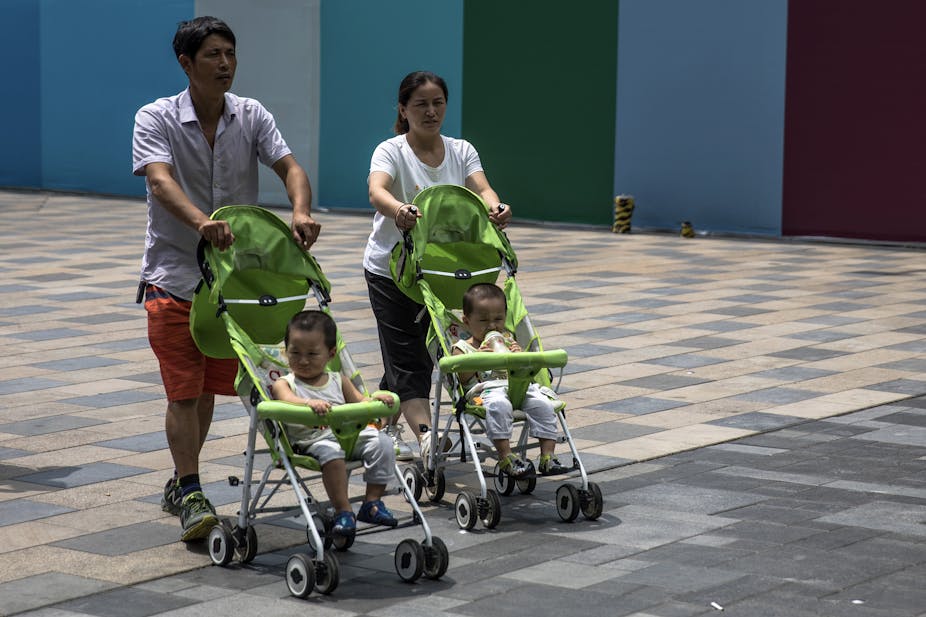There are signs that China’s infamous birth control restrictions – relaxed from a one-child to a two-child policy in 2015 – could be relaxed even further, if not removed altogether.
The first sign came from postage stamps. In 1980, just after the one-child policy was implemented, the postal service introduced a stamp showing a single (rather sad-looking) baby monkey to celebrate the zodiac cycle. In 2016, meanwhile, after the two-child policy was introduced, a stamp with two (much happier) monkeys was issued. In August, ahead of the year of the pig in 2019, another stamp was issued showing a very happy pig with three very happy piglets.
Of course, this is just a pig on a stamp. Back in 2007, a Chinese stamp was issued with five pigs playing with their mother – and, of course, a five-child policy did not follow in 2008.
Many have identified another possible signal which came in late August, with the publication of a Draft Civil Code which omits any commitments to family planning. It will be deliberated upon in September before its implementation. However, family planning is actually covered in the Population and Planning Law and, as such, does not need to be duplicated in the marriage section of the civil code.
However, in March 2018, in a much less noticed piece of administrative news, the National Health and Family Planning Commission was dissolved and folded into the new National Health Commission, possibly signalling a shift in resources away from policing family planning policy.
Demographic travails
All this is linked to the fact that China is one of the most rapidly ageing countries in the world. It’s also seeing a steady decline in its working age population which, in turn, is linked to wage inflation. I have argued elsewhere that a major motive for the “Belt and Road” initiative of Chinese infrastructure investment around the world is to take advantage of more favourable demographic circumstances in other parts of Asia and Africa.
But would relaxing the two-child policy even more actually achieve China’s goals to offset population ageing and stagnation by increasing fertility?
This is where years of studies of fertility preferences in China can come into play. A recent meta review of studies of fertility preferences in China between 2000 and 2011 found an average of only 4% of respondents wished to have more than two children. Even in rural areas, the mean ideal number of children was under two. The same study also found a significant negative relationship between education levels of women and their ideal number of children.
In a meta review I worked on of fertility studies between 1980 and 2009, my colleague Baochang Gu and I found that in most cases precisely nobody stated a preference for three children. Where they did, these respondents accounted for less than 5% of the total.
Of course, studies of fertility preferences in a country which tightly controls fertility – and which are often performed by family planning commissions themselves – need to be approached with caution. A 1990 study showed that when respondents were guaranteed anonymity in a fertility preference survey, they reported a higher desired number of children than those who were not.
Weak appetite for three children
From the direct costs of having children to the impact upon female career progression and structural issues relating to the cost of living, work culture, and the challenge of finding decent employment, there has arguably rarely been a worse time to expect Chinese people to have more children. As marriage is being postponed, couples are also having their first child later, which my ongoing research suggests is also lowering the overall fertility rate. And at this very moment, consumer confidence is also on the decline, not least as a consequence of uncertainty about global trade.
And it’s worth remembering that the response to China’s 2015 reforms to its birth control policies was relatively muted. There wasn’t a “baby boom” – making another one now seem unlikely.

These contextual issues are increasingly similar to other parts of East Asia which are grappling with low fertility. Take Taiwan, for example – a territory never subject to any birth control restrictions. In a 2010 national survey of married women, just 1.24% of women stated an intention to have three or more children.
Hopes pinned on more babies
But despite this weight of scientific, empirical and observational evidence, there is still a real anticipation among many observers, including Chinese officials, that further relaxation will bring about an end to China’s demographic woes. Part of the reason for this misplaced optimism is a false view that China’s birth control policies were a kind of “pressure valve” that held back a massive unmet desire for children. This comes from a view that it was birth control policies which were the predominant driver of fertility decline in the 1980s and 1990s. But put in context beside the nature of fertility declines elsewhere, as well as the revolutionary changes in economic and social conditions in China over the past two decades, then the idea of a “pressure valve” loses steam.
The reality is that relaxing birth control policies – or scrapping them altogether – is not going to be a magic solution to China’s demographic problems. A multi-dimensional approach to population policy which tackles the institutions associated with ageing, such as pensions and social care, is a first step.
Still, people in China currently do want more children than they have – even if it not three. Policies which seek to bridge this gap between aspirations and reality, not least through looking at circumstances in neighbouring territories as well better understanding why bringing up children seems so tough in China, will stand a much better chance of success. They would also have the added benefit of allowing citizens to meet some of their aspirations.

